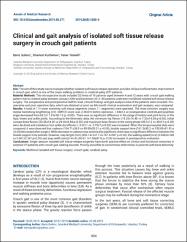| dc.contributor.author | Gülenç, Barış | |
| dc.contributor.author | Kuchimov, Shavkat | |
| dc.contributor.author | Temelli, Yener | |
| dc.date.accessioned | 2020-02-25T14:20:08Z | |
| dc.date.available | 2020-02-25T14:20:08Z | |
| dc.date.issued | 2019 | en_US |
| dc.identifier.citation | Gülenç, B., Kuchimov, S. ve Temelli, Y. (2019). Clinical and gait analysis of isolated soft tissue release surgery in crouch gait patients. Annals of Medical Research, 26(8), 1600-1604. http://doi.org/10.5455/annalsmedres.2019.05.271 | en_US |
| dc.identifier.issn | 2636-7688 | |
| dc.identifier.uri | https://hdl.handle.net/20.500.12511/4948 | |
| dc.identifier.uri | http://doi.org/10.5455/annalsmedres.2019.05.271 | |
| dc.description.abstract | Aim: The aim of this study was to evaluate whether isolated soft tissue release operation provides clinical and kinematic improvement in crouch gait, which is one of the major walking problems in cerebral palsy (CP) patients.Material Methods: This retrospective study included 32 limbs of 16 patients aged between 4 and 12 years with crouch gait walking pattern due to cerebral palsy between January 2004 and December 2013. All patients underwent multilevel isolated soft tissue release surgery. The preoperative and postoperative GMFSC level, clinical findings and gait analysis data of the patients were recorded. Pre-operative and post-operative data, which are obtained at post-op 6th month clinical examination and gait analysis, was compared.Results: A total of 114 lower extremity soft tissue segments (mean 7.1 segments) were operated. The most common surgery was medial hamstring lengthening (22). GMFCS score was 2.38±0.5 before operation, 1.69±0.4 at postoperative controls,and popliteal angle decreased from 65.2±11.9 to 60.15 (p <0.05) . There was no significant difference in the range of motion and joint forces of the hips, knees and ankle joints. According to the kinematic data, the minimum hip flexion (15.22±16.45 vs 7.33±14.34 p<0.05), initial contact knee flexion (33.25±14.26 vs 24.46±8.84 p<0.05) and maximum knee flexion in the swing phase (49.5±12 vs 43±11 p<0.05) were declined and midstance foot ankle dorsiflexion (-3.02±1 vs. 3.75±7 p<0.05) was increased. When the temporospatial data were compared, it was observed that cadence (104.71±38.5 vs 89.59±35.31 p <0.05), double support time (161.3±90.2 vs 150.09±81.91 p <0.05) decreased after surgery. While decrease in cadence was statistically significant, there was no significant difference between the double support time periods. However, step length (mm) (655.14±247.7 vs 767.5±307 p <0.05), the walking speed (m/s) (0.656±0.268 vs 0.667±0.267 p>0.05) and step width (mm)(144.41±50.61 147.94±87.8 p> 0.05) increased in postoperative evaluation.Conclusions: Single-session isolated soft tissue release surgeries have borth positive effect on clinical and functional outcomes in selected CP patients with crouch gait walking disorder. Priority should be to correct bone deformities in patients with bone deformity | en_US |
| dc.language.iso | eng | en_US |
| dc.rights | info:eu-repo/semantics/openAccess | en_US |
| dc.subject | Multilevel Isolated Soft Tissue Surgery | en_US |
| dc.subject | Crouch Gate | en_US |
| dc.subject | Cerebral Palsy | en_US |
| dc.title | Clinical and gait analysis of isolated soft tissue release surgery in crouch gait patients | en_US |
| dc.type | article | en_US |
| dc.relation.ispartof | Annals of Medical Research | en_US |
| dc.department | İstanbul Medipol Üniversitesi, Tıp Fakültesi, Cerrahi Tıp Bilimleri Bölümü, Ortopedi ve Travmatoloji Ana Bilim Dalı | en_US |
| dc.authorid | 0000-0002-4565-2315 | en_US |
| dc.identifier.volume | 26 | en_US |
| dc.identifier.issue | 8 | en_US |
| dc.identifier.startpage | 1600 | en_US |
| dc.identifier.endpage | 1604 | en_US |
| dc.relation.publicationcategory | Makale - Ulusal Hakemli Dergi - Kurum Öğretim Elemanı | en_US |


















